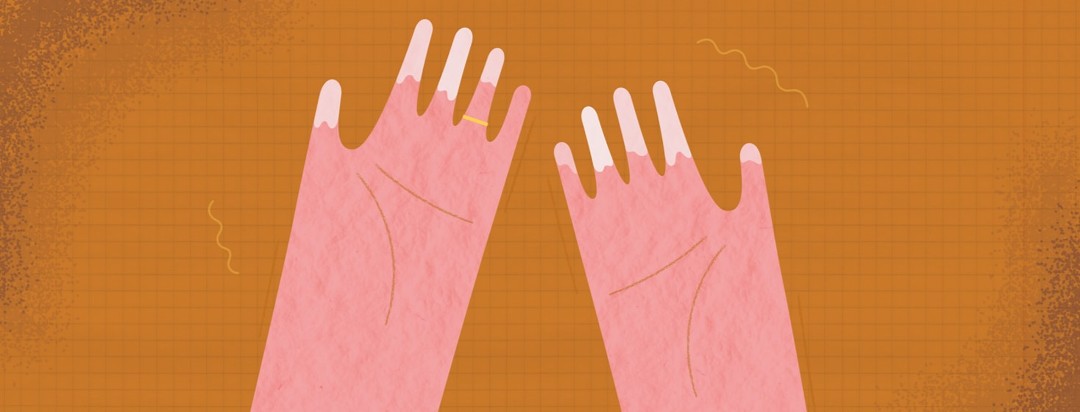What is Raynaud’s Phenomenon?
Psoriatic arthritis is a chronic autoimmune condition that causes inflammation and pain. When you have psoriasis or psoriatic arthritis you are at risk to develop other autoimmune conditions, meaning the immune system attacks the body instead of protecting it.1,2
Some researchers have suggested that genetic and environmental influences contribute to the development of autoimmune diseases. Characteristics of autoimmune conditions are that they attack the body, and if one exists you may develop other autoimmune diseases.2
What is Raynaud's phenomenon?
Raynaud’s phenomenon, sometimes called Raynaud’s disease is a clinical condition that affects the flow of blood to the extremities.3 The condition is not life-threatening but can affect your quality of life by limiting certain activities or climates.4
A rheumatologist generally diagnoses the condition. With Raynaud’s, spasms in blood vessels (vasospasms), can be brought on by cold, anxiety, or emotional stress. 3,4 This results in a decrease in blood flow to the fingers and toes causing them to experience extreme cold, a change in color, or sensation.
A look at the symptoms
The reasons for the development of primary Raynaud’s are unknown, but we do know cold temperatures and/or emotional stress can trigger it.
Symptoms include:
- Extreme sensitivity to cold
- Skin color changes
- Pain and numbness
- Warmth, tingling and throbbing
- Skin ulcers and gangrene7
As the body experiences cold, blood vessels in the extremities narrow to help retain warmth.7 In some cases, Raynaud’s also causes a systemic reaction, resulting in diminished blood flow to other areas including the ears, nose, nipples, and knees.3,6
For many, fingers and toes turn color from white to blue, and sometimes red. This change of color is due to reduced blood flow. When the skin turns white it is called pallor. As blood remaining in the tissues of an affected area loses oxygen it turns blue and is referred to as cyanotic.
What are some of the triggers?
When warm, oxygenated blood returns to the area it may turn red. There can also be pain or discomfort including a tingling or "pins and needles" sensation.4 Some people also develop sores on the pads of their fingers.
Physical symptoms of Raynaud’s don’t require extreme circumstances to be triggered. Relatively minor conditions, like holding a really cold drink or being in an air-conditioned room can bring on an episode of Raynaud’s.7 Raynaud’s attacks can come and go and the condition can last a lifetime.
How is it diagnosed?
There are 3 questions to ask about your fingers when determining the presence of Raynaud’s:
- Are they extremely sensitive to cold?
- Do they change color when exposed to cold weather or objects?
- Do they turn white, blue, or both?5
If you answer yes to all of the above then it is possible you have Raynaud’s and you should make an appointment to visit the doctor. When you visit a physician to discuss these symptoms you may be evaluated for underlying conditions frequently present with Raynaud’s.3
There are different types of Raynaud's disease
Raynaud’s requires a differential diagnosis. Doctors use clinical criteria and specialized blood tests to distinguish between primary and secondary forms.5,7
When Raynaud’s develops without other underlying conditions, it is considered uncomplicated and called primary. If other autoimmune conditions are present, it is referred to as a secondary form. Many people who are younger than 20 years old at the time of diagnosis have no underlying conditions and therefore require no additional testing.5
Primary Raynaud’s: 10% of the population has experienced primary Raynaud’s.4 They generally experience less severe symptoms. Some may have a family history of Raynaud’s in a close relative.5
Secondary: Onset of secondary Raynaud’s is less common and generally presents over age 30.6,7 When secondary Raynaud’s develops it can be more complex and the symptoms are often worse; it can be very painful, asymmetric, and skin irritations may develop.
What are treament options?
If you have psoriatic arthritis or another autoimmune disease, episodes of Raynaud’s may be reduced or controlled by effective treatment of your primary condition. It helps to avoid having a cold.5 Minimizing your time in cold weather or handling frozen items combined with making an effort to stay warm can be the best methods of prevention.
Learning how to dress appropriately can help; wear layers of loose clothing, socks, long underwear or tights, and a hat and gloves when it gets cold. Because emotional stress can also be a trigger, managing or avoiding anxiety-producing situations can also help to reduce episodes of Raynaud’s.5
There are currently no FDA-approved drugs indicated for the treatment of Raynaud’s phenomenon. Some medications currently prescribed for heart disease including for high blood pressure or chest pain, and chemotherapy, are also prescribed for the treatment of Raynaud’s.7
Tips to manage Raynaud's
Proactive treatment can decrease the duration and discomfort of an episode of Raynaud’s.7
- Stay dry: trigger an attack. Choose warm clothes that wick away moisture. Sweat can cool you off and trigger a reaction. Don’t go out with wet hair or skin.
- Stay warm: Keep your hands a steady temperature. Wiggle fingers and toes, rub hands together or put them under your armpits for warmth; consider wearing gloves inside if the temperature is cold or the heating malfunctions in winter.7
- Eliminate stress: Anxiety and emotional stress alone are enough to bring on symptoms of Raynaud’s. Try relaxation techniques including deep breathing, yoga or meditation. Some people find regular exercise, including Tai Chi, can also reduce anxiety, thereby reducing episodes of Raynaud’s.7
- Don’t smoke: Smoking or inhaling second-hand smoke causes blood vessels to narrow and can exacerbate Raynaud’s.7

Join the conversation